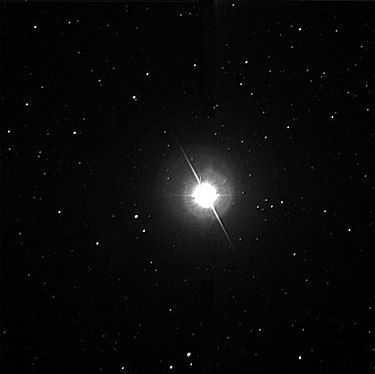
Altair (α Aql / Alpha of Eagles) is the most brilliant star in the Eagle constellation and the twelfth most brilliant star in the night sky.
Alongside Vega and Deneb, it creates the well-known “summer-autumn triangle” that is easily visible in the summer and fall months in the Northern Hemisphere. Within the Eagle constellation (alongside Beta and Gamma), Altair forms a famous line of stars sometimes referred to as the Eagle Family or Eagle’s Shaft.
Definitions and Brief Quotes about Altair [ edit ].
Altair is incredibly close to us, but also infinitely far away. [1]
It’s not Altair. There are no signs of the Zodiac. Above my head, the sky is cloudy. [2]
About twenty miles from here, if you follow the ditch, there is a region where people have been enslaved by extraterrestrials from Altair. These intelligent viruses take over the human body and control its actions.
The name of the now white star, Altair, translates to “flame” in Arabic, but it used to be red. [3]
There is my beloved Altair. Observe how brilliantly it shines, being a first magnitude star. It is flanked by Vega and Deneb. In the summer sky, they are known as the Great Summer Triangle. And in Arabic, Altair means a soaring eagle. [4]
Altair in the realm of popular science literature [ edit ]
When observing the century-long cycles of sunspots, one can clearly see an absolute increase in their numbers – a 27% increase compared to the beginning of the 17th century. However, this phenomenon is not limited to just the Sun. Take Sirius, for example, which was described as a red star during the time of the Egyptian pharaohs and even in the Middle Ages, but has since transformed into a white star. Interestingly, the name of the current white star, Altair, actually means “flame” in Arabic, which is associated with the color red. The most remarkable aspect of this transformation is the speed at which it is occurring, similar to the heating of the Sun, and is happening right before our very eyes. Can this be explained by current theories? To be honest, such a question is irrelevant as there are undeniable facts supporting this phenomenon. [3]
The arrangement of objects in the Universe follows a hierarchical pattern. Our galaxy, the Milky Way, is situated in the central region of the disk plane. The distance from our Sun to the core of the galaxy is approximately 8 thousand parsecs. A parsec is an astronomical unit of measurement equal to 3.26 light-years, with a light-year representing the distance light travels in one year. The immediate vicinity of the Solar System is referred to as the Local Interstellar Cloud (LIC), which encompasses nearby stars and star systems like Alpha Centauri, Sirius, Altair, and Barnard’s star. This neighborhood spans about 35-40 light years. It is worth noting that the Solar System is in constant motion within the MMO and is expected to exit it in roughly 10,000 years. [5]
Altair in memoir and fiction prose [ edit ]
Once upon a time, humans found it hard to believe that neighboring galaxies, such as the Andromeda Nebula, could possibly hold habitable planets. Even earlier, the mere thought of beings inhabiting planets like Arcturus or Altair was mind-boggling. However, today, humanity’s curiosity expands beyond the vastness of the universe with its countless galaxies, as we venture closer to the ominous abyss of the anti-world, which, to our surprise, is actually within reach.
On the east side of the moat, within the domain he protects, the inhabitants are held in bondage by extraterrestrials from the adjacent universe. These beings have also taken control, establishing feudal hierarchies and exercising their right to claim the first night with impunity. While these aliens may appear godlike, those who curry favor with them are not left entirely empty-handed. Roughly twenty miles from this location, following the path along the moat, lies a region where the Altair aliens have enslaved the population. These highly intelligent viruses have infiltrated the human body, manipulating their hosts to carry out their every bidding. Further westward, a substantial colony of the Galactic Federation can be found.
– That’s the reason for the unique appearance of the stars. There is Vega. And directly above is Orion – notice how Betelgeuse appears red and Bellatrix appears blue. And there is the alpha star of the Eagle, Altair. Doesn’t it resemble an eagle? The ladder hummed its never-ending, soothing tune. – Extending its wings and taking flight.
. the serpentine slave girls swayed and enchanted their master so that the outline of their breasts glowing in the darkness or the cascade of their hair would not obstruct Altair, Aldebaran, or the Shepherd’s Star. [6]
It is now nightfall. Above the towering trees of Steen-Nielsen’s garden, the sky takes on a greenish hue, and “my star” – Altair – illuminates it. I hurry home to retrieve a telescope and a star map, aiming to locate the constellations and attempt to observe the orbit of Jupiter – but it proves to be quite challenging: the tube quivers in my outstretched hand. The weather is chilly. I must get some sleep. [7]
Not only was I not put to sleep on the exam by our council, but also by Egyptian veterans. After all, I had not only read the works of conservative historical scholars, but also the books of all the progressive and ambitious ones. The latter were mostly contactists. They did not rely on the study of excavation history, but rather on information directly transmitted to them from outer space. They claimed to have discovered the secrets of the pyramids through various encounters – some with antimirs, some on the planet Sirius, some on Altair during astral travel in space. They would travel with a computer and immediately record the information they received. [8]
And there’s my beloved Altair, shining brightly in the night sky. It is a prominent first magnitude star, accompanied by the dazzling Vega and Deneb. These three stars together form the famous Great Summer Triangle, known as such in the summer sky. Interestingly, Altair gets its name from the Arabic word for “flying eagle.” So, in a way, I can imagine myself soaring through the heavens as Altair.
– Even if I were a flying donkey, Marie, I still appreciate the beauty of the constellations and the stories behind them.
– Of course, Altair belongs to the constellation of the Eagle, Vega to the constellation of Lyra, and Deneb to the constellation of Swan. [4]
Altair portrayed in verse [ edit ]
O mother of the nocturnal realm,
(O instrument of the world’s melancholy!)
O spectacles of Altair!
Slumber. O disgraced mane! [9]
Scattering grains across the Manchester
of the azure sky like a table,
he ignited all the lamps. There’s the Vesper
♪ radiating; there’s Alpha dispensing methol ♪
Into Altair’s basin. These torments
the night bestows upon poets with a star,
and they extend their hands
towards the acetylene moon. [9]
But, naturally, on the path of our Milky Way.
This world cannot be contained.
It is infinitely closer than Altair,
♪ Further away than Altair ♪ [1]
No Altair. No Zodiac.
Above us is a cloud
Tender as down amidst the illumination and shadow
Our snowy
our snowy trail. [2]
Hear ye!
The shimmering golden Chapel is illuminated!
Behold!
The resounding blue Altair echoes!
The ties have been severed. The heart has sung
Pouring its melodious voice into the exultant clergy. [2]
one dana mitzar shone as the king of mirrors and countenances.
deneb neb altair deneb altar to the heavens. [10]
Notes [ edit ]
- ↑ 12Sologub F.K., Collected Poems, vol. 7, St. Petersburg, 2002 (Triolet. Vosmistishie).
- ↑ 123Д. L. Andreev. Collected Works. – Moscow: "Russian Way", 2006.
- ↑ 12Vladimir Neiman"The Sun Shines Brighter and Brighter". – Moscow: "Technics for Youth", № 4, 1977.
- ↑ 12Waclaw Michalski"Two are needed for joy". – M.: Concord, 2005.
- ↑Viktor MagyarovCannibalism of Galaxies. – M.: Zerkalo Mir, No. 3, 2012.
- ↑Asar Eppel. “The Champignon of my life”. – M.: Vagrius, 2000.
- ↑Diakonov I. M. Book of Memories (1995). Foundation for European Regional Development. European University of St. Petersburg. House in St. Petersburg, 1995.
- ↑M.N.Zadornov. “Egypt”. – M.: “October” № 10 for 2002.
- ↑ 12Boris Lapin in the book “Russian Expressionism”. – Moscow: IMLI, 2005.
- ↑Konstantin Kedrov. “ILI. The Complete Collection of Poetic Works.” – Moscow: “Mysl”, 2002.
Check out these related links
- Wikipedia article
- Meanings in Wiktionary
- Texts on Wikiquote
- Media files on Wikimedia Commons
- News in Wikinews
Share these quotes on social media:
VKontakte – Facebook – Twitter – LiveJournal
If you’re curious about the star Altair and its location within the constellation, take a look at our article. This bright white star is situated in the equatorial constellation of Eagle and is the brightest star in its constellation as well as in our night sky. Deneb, Altair, and Vega form the well-known Summer Triangle asterism. These bright stars are some of the most prominent celestial objects that grace our night sky.

Distinctive qualities of the stars
What exactly is Altair? It is the designation given to Alpha Aquilae according to the Bayer system. Its name is derived from an Arabic expression which signifies “eagle in flight”.

Altair is a star that belongs to the main sequence and is classified as an A7V type. In 2005, the Alpha Eagle was designated as a variable star in the Shields Delta. This is due to its observed tiny fluctuations in luminosity, which are approximately a few thousandths of a star magnitude.


Due to its magnitude, an A-type star initiates the fusion of helium and enters the subgiant stage. As a primary luminosity star, it derives its energy from the fusion of hydrogen into helium. And it may already be progressing towards becoming a supergiant and initiating the fusion of helium in its core.


Altair is a celestial body that experiences the same destiny as the Sun during its later phases.
Upon assimilating hydrogen, it will undergo helium burning and transform into a red giant. Subsequently, it will generate a planetary nebula and leave in its wake a compact leftover known as a white dwarf.


Altair possesses over five visual companions that are not physically linked to it. The companions are situated at a considerable distance from the primary star.

Did you know: According to Wikipedia, Altair, which is slightly larger and more massive than the Sun, is about 1.2 billion years old, making it much younger than our Sun, which is approximately 4.6 billion years old.

Type Aquilae
- White (Type A) is the color of Altair;
- Altair belongs to the spectral type A 7 V;
- The visible stellar magnitude of Altair is 0.76;
- Altair has an absolute stellar magnitude of 2.22;
- The mass of Altair is 1.83 solar masses;
- Altair has a radius of 1.79 solar radii;
- The luminosity of Altair is 10.6 solar;
- Altair is located at a distance of 16.73 light-years/5.13 parsecs from the solar system.


NOTABLE: Altair possesses a mass that is almost double that of the Sun, a radius approximately twice as big, and a luminosity of 10.6.
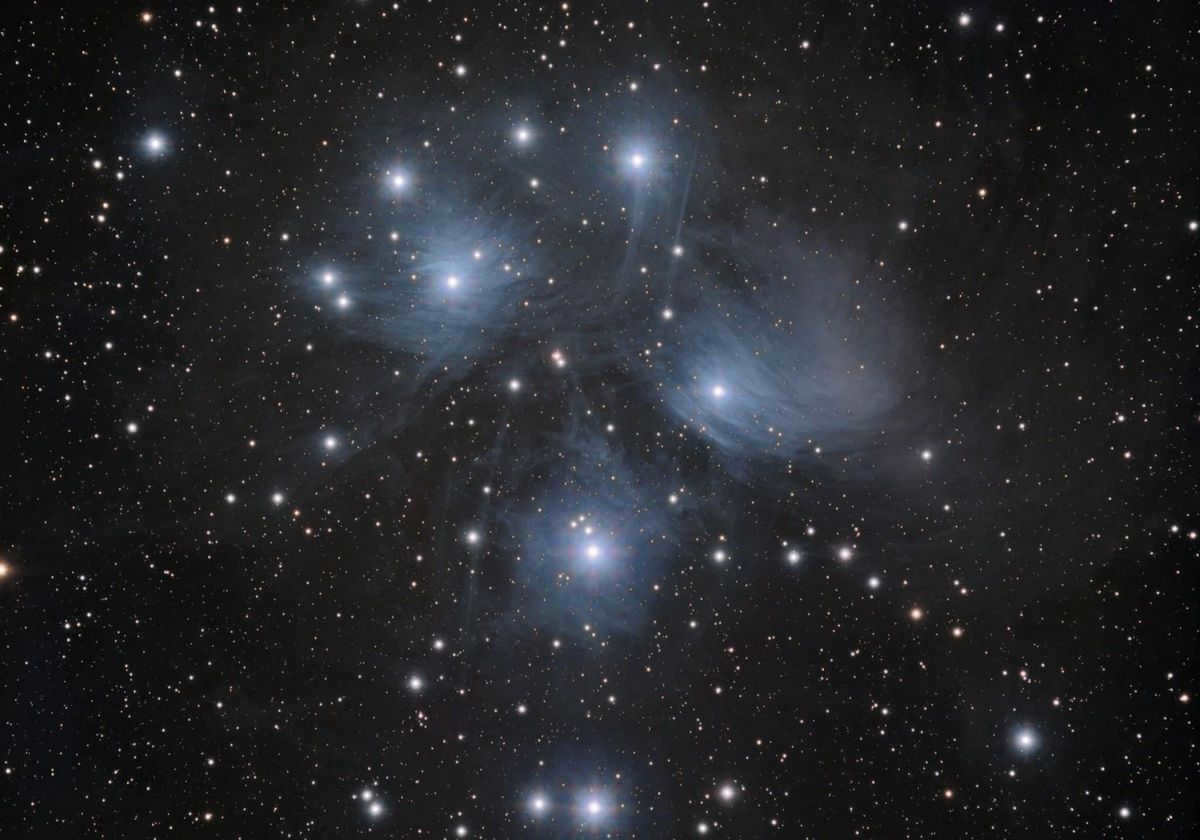

Understanding Altair (video)
Physical Appearance
Altair, the most prominent feature in the expansive Eagle constellation, is often referred to as the “eagle’s gaze” due to its positioning in the heavens, resembling the pattern of a celestial eagle. It is also identified as 53 Aquilae and HIP 97649 in alternative star catalogues.
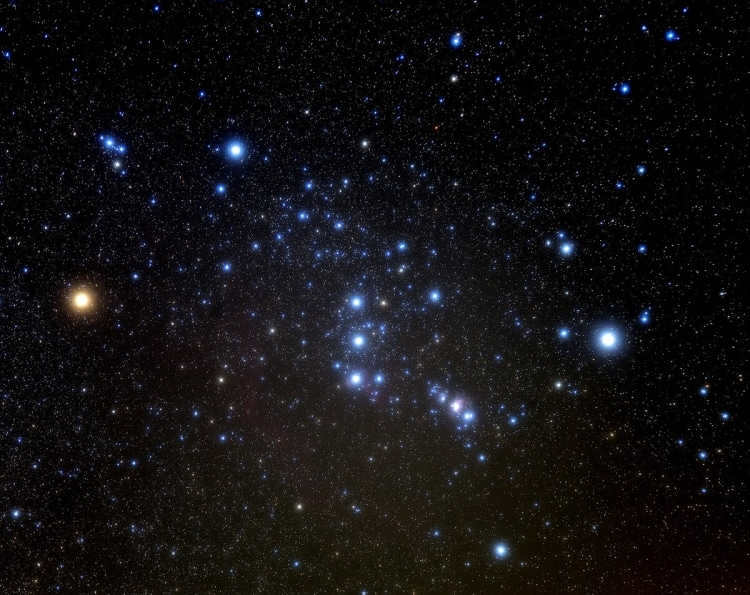

Altair, which has a visual magnitude of 0.76, is recognized as the twelfth most luminous star in our nocturnal firmament. It belongs to the A7V spectral class and emits a brilliant white hue that is readily observable without the aid of optical instruments.


The spectral class “V” signifies that Altair is a main-sequence celestial object, similar to our Sun. This implies that it produces energy by burning hydrogen in its core. Alpha Eagle has a mass 1.83 times greater than our Sun and a radius 1.79 times larger than the Sun.

Did you know?: Aquila boasts an impressive rotational speed of 8.9 hours. Additionally, its equatorial diameter measures 20% greater than its polar diameter.


Closest Neighbor
Altair happens to be one of the nearest stars to the Solar System, located a mere 16.73 light-years away.
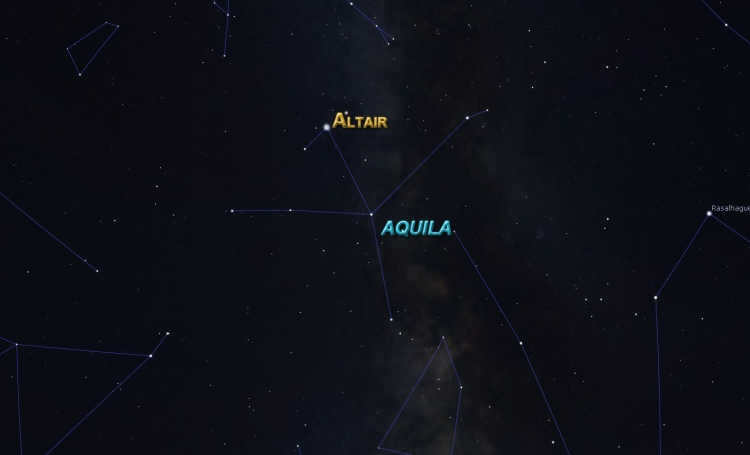

Astronomers were able to capture a detailed image of Altair’s surface using the Michigan Infrared Combiner (MIRC) at the Center for High Angle Resolution Astronomy (CHARA). Only a handful of stars have been observed directly from Earth’s surface. (see Photo).


FASCINATING: Altair is relatively near to us in comparison to other stars. This is the reason why it appears so luminous from our planet.

Study and Mythology: A Historical Perspective
Ancient cultures have long revered the constellation of Eagle, depicting it as a magnificent flying creature. Notably, the brightest star in this constellation has been christened Altair.
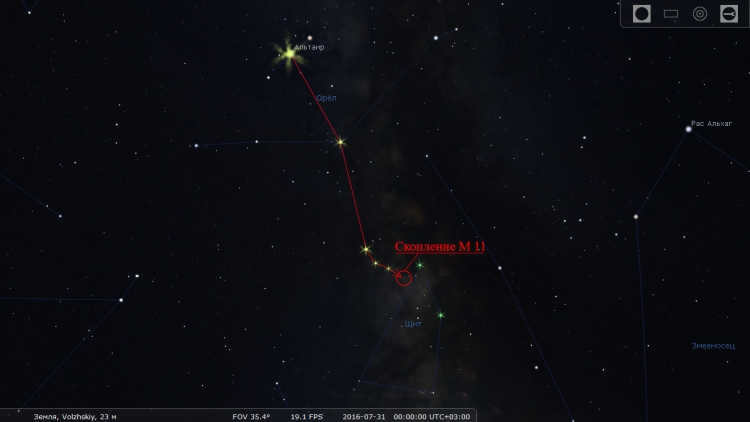

Originating from Arabic, Al Nasr Al-Tair, Altair is referred to as the “flying vulture” by the Romans, known as Aquila Vultur Volans. The star Altair has also been called the “Star of the Eagle” by ancient civilizations such as the Babylonians, Sumerians, and Egyptians.
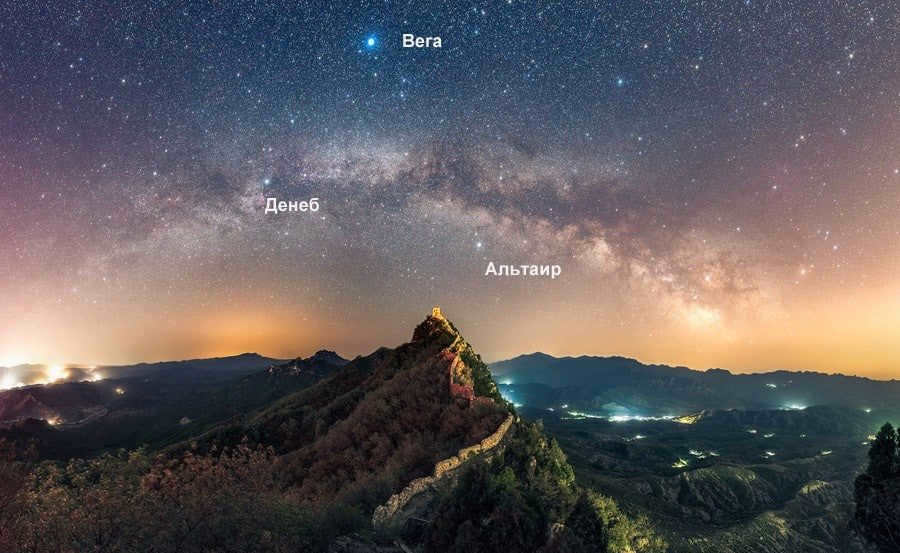

Altair has various designations in different societies. The Koori tribe referred to it as Bunjil, while the Murray River tribe called it Totirgil. In Chinese culture, it is known as Hé Gǔ er, which can be translated as the “Second Star of the River Drum”.
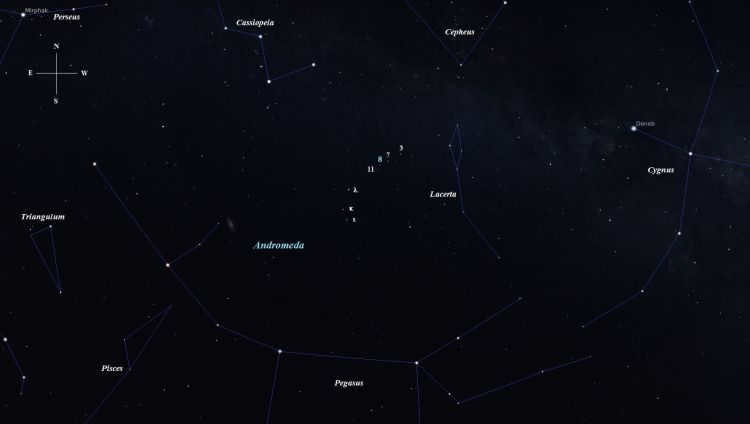

This forms a portion of a constellation known as Hé Gǔ or “river drum”. Its more popular designation is Niu Lan Xing, which translates to “herder star”.

In 2007, NASA released a publication in which they designated the Lunar Surface Access Module (LSAM) as the Altair, in honor of the celestial body. Presently, in the field of astrology, the Star Altair holds significance as it is utilized in the creation of a natal chart.
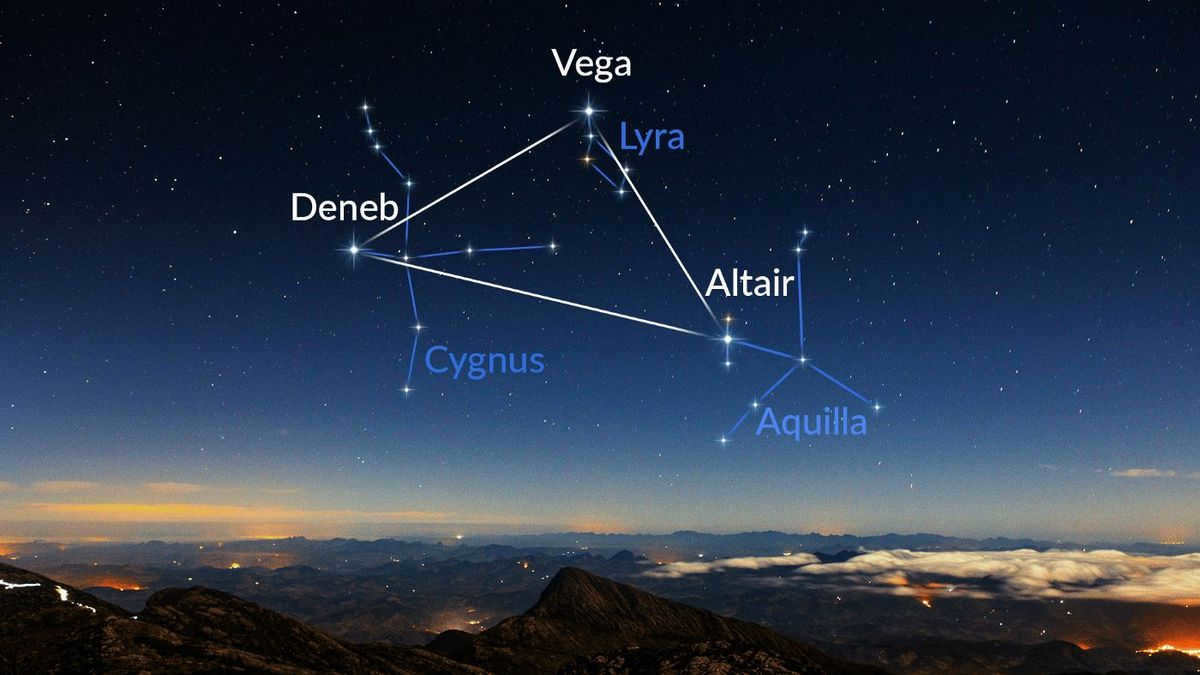

Were you aware that.
- Regarding Western astrology, the emergence of the Eagle constellation in the celestial sphere was an ill omen and foreshadowed peril from reptiles.


- The sailors of Indonesia Boogie utilize Altair as a navigational tool and refer to it as the star of the east.

- It appears that the luminary possesses three visual satellites that can be seen from the same perspective. However, these satellites are located at a greater distance and are not physically linked.
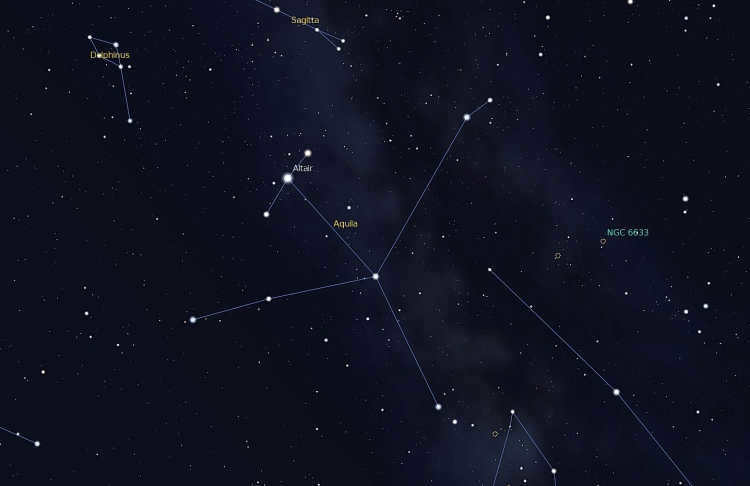

- According to Chinese mythology, the stars Vega and Altair symbolize a shepherd and a weaver who can only meet each other by crossing a celestial bridge created by a flock of forty flying over the star Deneb.
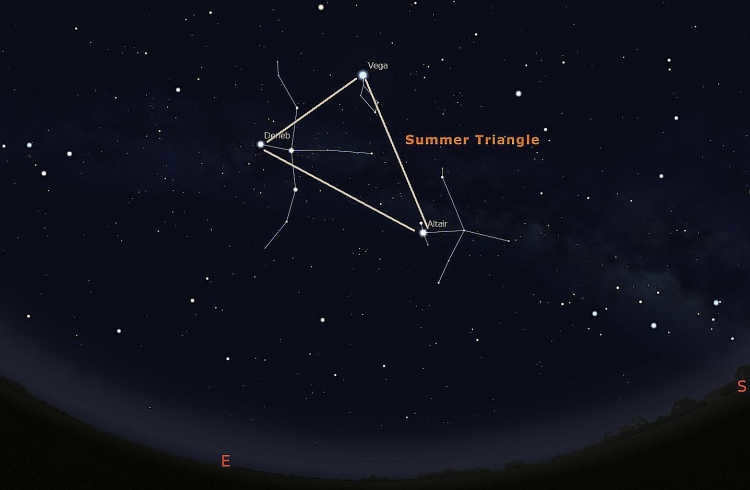

- The wedge-tailed eagle was recognized by the Australian Aboriginal Koori people as Altair, with its two other prominent stars in the constellation serving as its spouses.
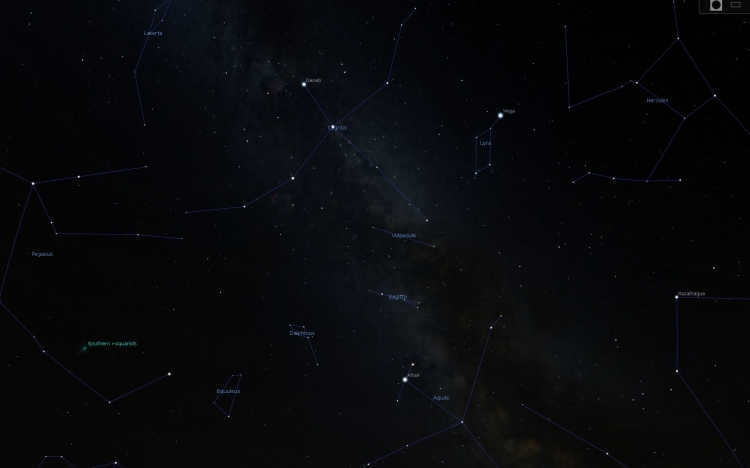
- Ptolemy, the Greek astronomer, cataloged the Eagle star, along with several others, in the 2nd century.
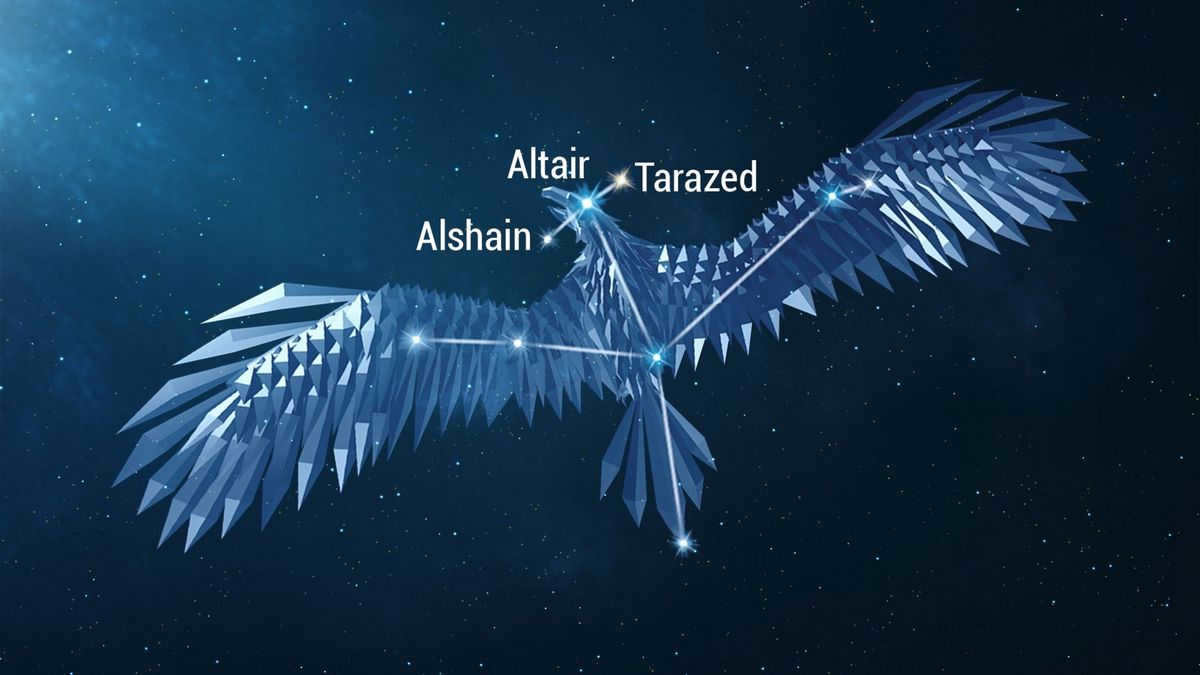
The ideal time to witness Aquila is during the summer and fall seasons, when it becomes visible approximately 90 minutes after sunset.
As we reach the end of September, Aquila begins to ascend towards the meridian as evening descends, and by the end of the year, it sets earlier – about 3 hours after sunset.
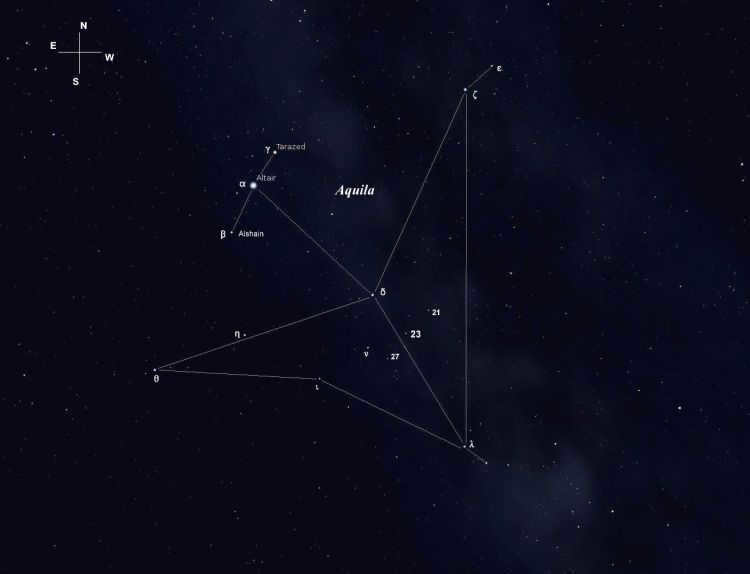

Altair: A Special Star (video)

Altair ibn La-Ahad. (Arabic الطائر ابن لا أحد) is a prominent member of the Syrian Brotherhood of Assassins and serves as both a Master Assassin and Mentor. He is also known as an ancestor of Desmond Miles.
- 1 Life story
- 1.1 Early years and adolescence
- 1.2 The Assassination of Masyaf
- 1.3 Pursuit of the Cup
- 1.4 The Quest for Adha
- 1.5 The Hunt for the Apple
- 1.6 The Nine Objectives
- 1.7 After the demise of Al-Mu'alim
- 1.8 Journey to Cyprus
- 1.9 Assassination of Genghis Khan. Return to Masyaf.
- 1.10 Study of the Apple
- 1.11 Reinstatement as Mentor
- 1.12 Demise of Altair
Biography
Early Life and Adolescence

Altair was born in Masyaf, in 1165 AD. His father, Umar ibn La-Ahad, was a member of the Order of Assassins, while his mother tragically passed away during childbirth.
In 1176, Masyaf faced its first siege by the army of Salah al-Din. During this time, Umar ibn La-Ahad was given the mission to infiltrate the enemy camp and deliver a message after the spy Ahmed Sofian discovered al-Din’s tent. Umar came close to completing the task, but was ultimately discovered. Despite this setback, he managed to escape from the camp, even taking down one of the Saracen army’s generals in the process.
During the negotiations for peace between the Saracen army and Masyaf, the Saracens insisted that Umar be executed in retaliation for the general he had killed. If the Assassins were to reject this demand, the Saracens threatened to prolong the siege of Masyaf and kill their captive, Ahmed. The leader of the Assassin Order, Al-Mu’alim, found himself with no other option but to carry out Umar’s execution. As Umar met his fate, he could hear the anguished cries of his 11-year-old child.
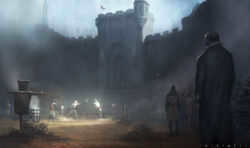
Altair held Ahmed responsible for the death of his father. Subsequently, consumed by remorse, Ahmed took his own life in front of Altair. Al-Mu’alim instructed Altair to keep this a secret, even from Ahmed’s son, Abbas. Abbas was deceived, being told that his father had permanently departed from Masyaf. The following day, Altair and Abbas commenced their training within the Order.
The assault on Masyaf

In 1189, Masyaf was invaded by the Templars, resulting in the capture of Al-Mu’alim and three other assassins. The Templars received assistance from Haras, a member of the Order of Assassins who betrayed his comrades. However, Altair managed to infiltrate the fortress and successfully rescue Al-Mu’alim while eliminating Kharas. As they walked together, Al-Mualim expressed his pride in Altair’s actions and noted the resemblance between the Assassin and his father. As a result of this mission, Altair ascended to the rank of Master Assassin.
The Quest for the Championship
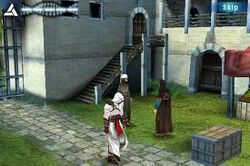
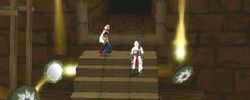
She informs him that the deputy of Al-Mualim, Aleppo Harash, has betrayed them and joined forces with the Templars. Altair suggests that she make her escape on a ship that is currently docked in Tyre, and Adha agrees. However, before she leaves, she asks Altair to eliminate Harash. Altair arrives in Aleppo and successfully eliminates the treacherous Harash, where he discovers that Adha has been captured at the port in Tyre. Upon reaching Tyre, Altair learns that Basilisk is holding Adha captive at the Templar port. As he makes his way through the numerous Templars, he catches sight of his beloved being held on a ship. But standing in his path is Basilisk, with whom he engages in a fierce battle for the third time.

After a lengthy conflict, Altair successfully defeated the Basilisk. However, Altair was unable to rescue his beloved as the vessel holding her had already departed. As he gazed at the shoreline, Altair witnessed the Templar ship carrying Adha vanish into the distance. It was at that precise moment, while gazing up at the sky, that Altair made a solemn vow to himself: “I shall locate you, Adha!”
The Quest for Adha
During the period from 1190 to 1191, Altair embarked on a relentless search across the vast sea in hopes of finding the elusive ship that held Adha captive. His determination paid off as he eventually located the vessel, but alas, it was a bittersweet victory. Within its confines lay the lifeless body of Adha, forever lost to him. Consumed by grief and rage, Altair vowed to exact vengeance upon those responsible for her demise, although it provided little solace or satisfaction. In the wake of Adha’s tragic demise, Altair believed that he would never be capable of experiencing the same profound love he had once shared with her.
Apple Pursuit
In the year 1191, Altair embarks on a crucial quest alongside Malik and Qadar, the brother of Malik. This mission is entrusted to them by Al-Mu’alim, their leader. They are instructed to infiltrate the Temple of Solomon, the very site where the Templar camp is situated. The wise elder commands the assassins to cunningly retrieve a significant artifact from the stronghold, all while avoiding detection. However, during the execution of this task, Altair deviates from the Creed of the Brotherhood by mistakenly taking the life of an innocent bystander.

Within the temple, Altair encounters Robert de Sable, the Grandmaster of the Templar Order, who is also on the hunt for the Apple of Eden. Despite being instructed to only eliminate Robert in dire circumstances, Altair chooses to confront him head-on. Despite the pleas and objections of his comrades, Altair opts for a direct assault. Ultimately, it is Malik who intervenes and prevents Altair from executing de Sable at the very last moment. In a surprising turn of events, Altair finds himself captured by Robert and unceremoniously cast out of the Temple.
The Master of the Order commands Altair, his comrade, the trainer of assassins Rauf, and another assassin to ascend a tall tower and perform the Leap of Faith, in an attempt to demonstrate to the Templars that assassins are prepared to fight to the very end and possess no fear of death. All of the assassins successfully completed the leap, as they had leapt into a haystack placed on the ground below the tower. However, the third assassin suffered a broken leg upon landing, and Rauf was left to assist him. Altair flanked the Templar army from behind and activated a clever trap, annihilating the primary forces of the Order and compelling Robert to retreat. Nevertheless, despite Altair’s significant aid in recent times, Al-Mu’alim publicly executes his apprentice.
It was never his intention to eliminate the assassin. The mentor held his apprentice in high regard, knowing that he was the only one capable of completing the task that Al-Mu'alim would soon assign to him. The act of execution merely serves to demonstrate the Brotherhood’s just system of punishment, as Al-Mualim cannot make exceptions to the iron discipline even for his most favored individuals.
Nine objectives
As a result, Altair is compelled to commence his training anew in order to restore his reputation within the Order. The most skilled assassin in the Brotherhood finds himself stripped of all his gear! However, there is no recourse – Altair must comply with his mentor’s orders. Furthermore, nearly every assassin in the Brotherhood has developed animosity towards him and subjects him to constant humiliation through cutting remarks and jests.
First of all, the elder assigns him the task of locating and apprehending the betrayer from Masyaf. It has been discovered that someone betrayed the Assassins and allowed the Templars to enter the city before the siege. With only minimal information provided, Al Mualim steps back and Altair quickly begins his mission. He is educated on the ways of the Assassins, starting as a novice. One of his fellow brothers explains the methods of identifying and targeting a victim. Although Altair already knows this information, his brother is following orders. Practice makes perfect. Eavesdropping and stealing the necessary documents, Altair successfully discovers the traitor and brings him to Al-Mualim. Despite the elder’s impassioned speeches, the traitor refuses to repent, resulting in his immediate execution. Altair has passed the test, but his journey is just beginning. Al Mualim reveals that Altair must eliminate nine targets in exchange for his own life. After a thorough explanation of the mission’s complexities, Al Mualim instructs Altair to get to work.
Altair anticipated a trap as he approached the final Templar on his list, Robert de Sable, whom he had previously encountered in the Temple of Solomon. The Templars were already aware of the danger and prepared for the encounter. After a fierce battle, Altair finally reached his target, only to discover that it was not Robert, but a woman named Maria who was also a Templar. Maria revealed that she had been eagerly awaiting the deceived assassin’s arrival. Despite this unexpected twist, Altair chose to spare Maria’s life and continued his mission to find his true target.

Upon vanquishing countless adversaries and eliminating his final, ninth target, he makes his way back to his abode in Masyaf. It transpires that Al-Mu'alim had betrayed the Brotherhood by harnessing the power of an ancient relic known as the Apple of Eden to subjugate the inhabitants of Masyaf, and Altair was tasked with eliminating those who sought to possess the artifact, Al-Mu'alim’s rivals.
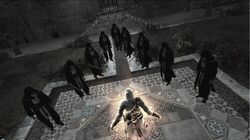
Al-Mu'alim is defeated by Altair in a fierce combat and contemplates destroying the artifact. However, he ultimately chooses to preserve it, with the hope of discovering a beneficial purpose for the artifact that would benefit humanity.
Following the demise of Al-Mu'alim.

Altair sends his friend Malik on a mission to Jerusalem to deliver a message to the assassins residing there. Altair himself orders some of the assassins to set a bonfire as a signal to confirm Al-Mualim’s demise. While addressing the residents and fellow assassins, Abbas cunningly pushes Altair off a ledge and seizes the Apple. Altair is compelled to save Abbas, who was unprepared for the immense power of the artifact. Ultimately, Altair successfully retrieves the Apple.
Several months later, in late 1191, Armand Bouchard took over as the leader of the Templar Order after Robert De Sablet’s death. Altair and his fellow assassins launched an assault on the port at Acre in search of Bouchard. However, when they arrived, Altair encountered Marie Torpe, a former servant of Robert de Sablet. He defeated her once again and learned that the Templars were determined to retrieve the Apple of Eden that he had taken, as well as information suggesting that Richard I had sold the island of Cyprus to the Templars. Altair made the decision to journey to the island in order to uncover his enemies’ plans.

After arriving in Cyprus and discovering fellow Assassins, Altair receives news of the completion of an archive on the island, housing vital information and weaponry. During this time, Maria is apprehended by Armand Bouchard, who accuses her of betrayal. Altair comes to her rescue, leading Maria to reconsider her beliefs and join forces with the Assassins. Altair subsequently eliminates six of Bouchard’s associates before engaging in a fierce confrontation that results in Bouchard’s demise. Following the rescue of Maria, the archive facility is destroyed. During their time in Cyprus, Altair and Maria develop a close bond and several months later, they tie the knot in Limassol. In 1195, Maria and Altair welcome their first child, Darim. Two years later, their second son, Sef, is born.
In 1217, the Empire of Genghis Khan was experiencing rapid growth, posing a challenge to the expansion of the Assassin Order in the area. Furthermore, Altair held the belief that Genghis Khan possessed one of the Pieces of Eden, the sword. To address this, Darim, Mary, and Altair embarked on a journey to Mongolia with the intention of assassinating Genghis Khan. In the interim, Malik assumed temporary leadership of the Order (although Altair later states in Assassin’s Creed Revelations that Malik was killed by Abbas), while Seth remained in Masyaf to care for his family.
Altair, Maria, and Darim spent a total of 8 years residing in Mongolia. During their time there, they collaborated with Kulan Gal, a renowned assassin whose likeness was eventually immortalized in a shrine at Villa Auditore. Together, they devised a masterful plan to eliminate the formidable Genghis Khan. In due course, Altair and Kulan Gal managed to infiltrate the enemy’s encampment. Altair, who had experienced a decline in his former prowess due to age, deliberately allowed himself to be discovered. As a result, he sustained injuries, but Kulan Gal swiftly came to his aid. Genghis Khan attempted to flee, yet Kulan Gal’s arrow swiftly caught up to the renowned commander’s steed, while Darim delivered the victim a fatal blow from his crossbow. With their mission successfully accomplished, Altair and his family journeyed back to Masyaf.
In the meantime, in Masyaf, a conspiracy was hatched by Abbas and his loyal associate, Swami, to overthrow the current leadership of the Order. Swami deceitfully murdered Seth, falsely claiming that it was done under Altair’s command. To further implicate Malik, Abbas planted the murder weapon on him, resulting in his imprisonment.
Upon Altair and his family’s return to Masyaf, Darim set out to find Sef, who was rumored to have left for Alamut. Altair and Maria convened with the Council of Assassins, who informed them of Seth’s death and accused Malik of the act. Desiring to reclaim his authority, Altair demanded control of the Order, but the Council refused. Losing faith in the Council, Altair decided to take matters into his own hands. He broke into the prison and freed Malik, who then revealed the truth to him.
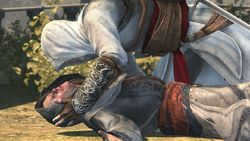
Altair made another attempt to confront Abbas. However, Abbas managed to gather a group of assassins from the Order to support him. Abbas commanded Swami to behead Malik and bring his severed head as evidence that Altair had sought revenge. Swami pleaded with Altair to hand over the Apple of Eden. As Swami approached Altair, he whispered the same words that were spoken to Sefu before his demise. Altair became consumed with anger and, using the power of the Apple, compelled Swami to harm himself with a blade. In an unfortunate twist of events, Mary was unintentionally injured and lost her life. Altair managed to escape from Masyaf and spent the next two decades residing in Alamut with Darim and Seph’s family, dedicating his time to studying the Apple.
Exploring the Apple
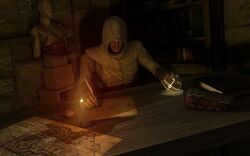
Darim, Seth’s wife and daughter, became concerned about Altair’s intense focus on the Apple. They decided to take a trip to Alexandria, and later Darim traveled to France and England.
One fateful day, the Apple directed Altair’s attention to five seals that he needed to locate. These seals held a message for someone in the future. The artifact revealed a wealth of new and unknown information to Altair. Inspired by this knowledge, Altair created a revolutionary new type of metal. He used this metal to forge incredibly strong armor and invent a double hidden blade, incorporating numerous improvements and adjustments.
Reclaiming the Mentor Title
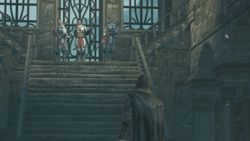
In 1247, Altair was roused from his slumber near Masyaf by a merchant named Tazim al-Saif, the son of Malik. Tazim expressed his unwavering loyalty to the ancient Creed, inspiring Altair to gather a group of 20 faithful Assassins and the citizens of Masyaf to initiate a rebellion. The rebels easily infiltrated the fortress of Masyaf, encountering little resistance from the complacent assassins within. Ultimately, Altair and Abbas confronted one another.
Despite Altair’s account of his father’s demise, Abbas remained skeptical and dispatched his most loyal soldiers to attack Altair. In a decisive moment, Altair raised his arm and unleashed a concealed pistol he had crafted, mortally wounding Abbas. As he lay dying, Abbas vowed that the truth would soon be revealed.
Following these incidents, Altair resumed his role as the Mentor of the Order of Assassins in Masyaf. Subsequently, he assembled a collection of books and safeguarded it with five seals. In 1247, Altair tasked his son Darim with inviting Niccolo and Matteo Polo, two Venetian explorers, to Masyaf. He relayed his life’s tale to them, which he meticulously documented in a journal.
The Demise of Altair

In the year 1257, the Mongols launched an assault on Masyaf. Alongside Altair and the few remaining assassins present, there was also Nicolo, the father of the renowned Marco Polo. Taking the seals from Altair, Nicolo concealed them in Constantinople. Despite being 92 years old, Nicolo proposed that Altair depart from Masyaf, but Altair declined the offer.

Altair made his way towards the library and instructed his son, Darim, to conceal the books and live a peaceful life, cherishing his family. After bidding his final farewell, Altair shut the library door, entered inside, extinguished all the torches, and hid the Apple of Eden behind two stone doors. He then took a seat on a chair and passed away, leaving behind a seal-artifact that would be discovered by Ezio Auditore da Firenze many years later.
Personality and Characterization
Altair was not known for being the most amiable student. He frequently displayed rudeness and insolence towards his fellow assassin brethren. His temperament was often irritable, boastful, and egocentric. There were instances where he even violated the Assassin Creed. However, despite his transgressions, Al-Mualim held his apprentice in high regard and recognized his immense potential.
With a personality like his, it was difficult for Altair to form friendships. He was no exception in this regard. While some individuals respected him to the point of groveling, others harbored disdain and envy towards him. One significant figure in his life was Malik, another assassin who frequently carried out missions for the Order alongside Altair. Malik, like many others, did not have a fondness for Altair, and it was only the Brotherhood’s creed that prevented them from engaging in physical altercations. However, this did not stop them from engaging in constant quarrels and prolonged arguments, in which Altair typically emerged victorious.
Fascinating information
- Altair, Ezio, Desmond, and Aveline share the same distinctive scar on their lip.
- In the E3 trailer of the game Assassin’s Creed, Altair can be seen wielding a crossbow, although it didn’t appear in the final version of the game.
- Throughout the entire game, Altair only removes his hood once before his demise.
- Altair’s attire can be acquired through Uplay in Assassin’s Creed II and Assassin’s Creed: Blood Brotherhood.
- In AC: Revelations, when Ezio discovers the seals, he is transported into Altair’s body, reliving his life (similar to Desmond), from his youth to old age.
- Altair is 5 years younger than his wife Maria.
- The connection between Altair and the eagle is not coincidental. Altair is the brightest star in the Eagle constellation.
- Additionally, Altair translates to “soaring eagle” in Arabic.
- Altair is a white hot main-sequence star, commonly referred to as a white dwarf.
- With an age of approximately 1 billion years, Altair is considered relatively young.
- Altair is located at a distance of 5.15 parsecs (equivalent to 159 trillion km) from the Solar System. It resides within an interstellar cloud composed of gas and dust.
- The mass of Altair is estimated to be around 1.8 times that of the Sun.
- Altair has an average radius of about 1.7 times that of the Sun. Its rapid rotation causes it to be noticeably flattened, with the equatorial diameter being 22% larger than the polar diameter.
- The temperature on the surface of Venus is approximately 8220 degrees Celsius near the poles, while it decreases to 6620 degrees Celsius towards the equator.
- Venus has an equatorial rotational velocity of 286 km/sec, which is much higher compared to the Sun’s rotational velocity of 2 km/sec.
- According to measurements, Venus has a radial velocity of -26.1 km/sec, consistently approaching the Earth.
- In the novel “Bodyguarder” (1960) by American science fiction writer Christopher Grimm, the seventh planet of Altair, called Vinau, is home to unique creatures known as vins. These vins have been alive for approximately 2000 years and are known for their involvement in the game of zerkle, a body-swapping game.
- In Ursula le Guin’s story “April in Paris,” an alchemist summons a resident of Altair from the future. This resident is a descendant of Earth colonists and explains that she came to Earth because she grew tired of her homeland on Altair. On Altair, people are highly developed, successful, and prosperous, leading to a lack of challenges or problems.
- In Stephen King’s novel “The Tommyknockers”, a young boy unintentionally transports his brother to one of the planets in the Altair system while performing magic tricks for his guests (although it is later revealed that it is not actually Altair).
- Altair is the name of the protagonist in the video game series Assassin’s Creed, specifically in the first installment and Assassin’s Creed: Revelations.
- ↑ Astronomical calendar. Constant part. 7th edition, revised. Edited by V. K. Abalakin. – Moscow: Nauka, 1981
- ↑ The first image of the surface of Altair was obtained
- ↑ The stellar interferometer at Narrabri Observatory-II. The angular diameters of 15 stars, R. Hanbury Brown, J. Davis, L. R. Allen, and J. M. Rome, Monthly Notices of the Royal Astronomical Society137 (1967), pp. 393–417, Bibcode: 1967MNRAS.137..393H.
- ↑ Altair’s Oblateness and Rotation Velocity from Long-Baseline Interferometry, Gerard T. van Belle, David R. Ciardi, Robert R. Thompson, Rachel L. Akeson, and Elizabeth A. Lada, Astrophysical Journal559 (October 1, 2001), pp. 1155–1164, DOI:10.1086/322340, Bibcode: 2001ApJ. 559.1155V.
- ↑ In the study “Resolving the Effects of Rotation in Altair with Long-Baseline Interferometry” by D. M. Peterson et al., published in The Astrophysical Journal636, #2 (January 2006), pages 1087–1097, the authors investigate the impact of rotation on Altair utilizing long-baseline interferometry. The paper can be found with the DOI: 10.1086/497981 and the Bibcode: 2006ApJ. 636.1087P. Please refer to Table 2 for detailed stellar parameters.
- ↑ The article “Asymmetric Surface Brightness Distribution of Altair Observed with the Navy Prototype Optical Interferometer” by Naoko Ohishi, Tyler E. Nordgren, and Donald J. Hutter, published in The Astrophysical Journal612, #1 (September 1, 2004), pages 463–471, presents the observation of Altair’s asymmetric surface brightness distribution using the Navy Prototype Optical Interferometer. The paper can be accessed with the DOI: 10.1086/422422 and the Bibcode: 2004ApJ. 612..463O.
- ↑ The gravitational-darkening effect of Altair observed through interferometry was studied by A. Domiciano de Souza, P. Kervella, S. Jankov, F. Vakili, N. Ohishi, T. E. Nordgren, and L. Abe in their paper titled “Astronomy and Astrophysics” (442), #2 (November 2005), pp. 567–578, DOI:10.1051/0004-6361:20042476, Bibcode: 2005A&A. 442..567D.
- ↑ In a press release by the National Science Foundation titled “Gazing up at the Man in the Star?” (07-062) on May 31, 2007.
- ↑ J. Monnier et al. published a paper titled “Imaging the Surface of Altair” in the journal “Science” (317), #5836 (July 20, 2007), pp. 342–345, DOI:10.1126/science.1143205, Bibcode: 2007Sci. 317..342M. The stellar parameters can be found in the second column of Table 1. Accessed online on November 25, 2008. See second column of Table 1 for stellar parameters.
The British Brotherhood, Chinese Brotherhood, Colonial Brotherhood, Egyptian Brotherhood, Indian Brotherhood, Italian Brotherhood, Syrian Brotherhood, Mongolian Brotherhood, North European Brotherhood, North Korean Brotherhood, Paris Brotherhood, Roman Brotherhood, Russian Brotherhood, Saint Dominican Brotherhood, South Korean Brotherhood, and West Indian Brotherhood.


Altair, located in the constellation of the Eagle (Aquilla Constellation, situated on the bird’s “neck”), is renowned as the most brilliant star. It holds the 12th spot among the brightest stars visible in the sky and can be easily spotted without the aid of any optical instruments.
The star derives its name from an Arabic term that signifies “soaring eagle.” Altair has been known to numerous cultures for several ages, such as Ancient Greece, where it was referred to as “Ethos” (meaning “Eagle”). The Sumerians and Babylonians recognized it as the “Eagle Star,” while the Micronesian people called it the “Big Bread.” The Maori people referred to Altair as the “Celestial Pillar,” and it is sometimes even called “Jupiter’s Bird.”
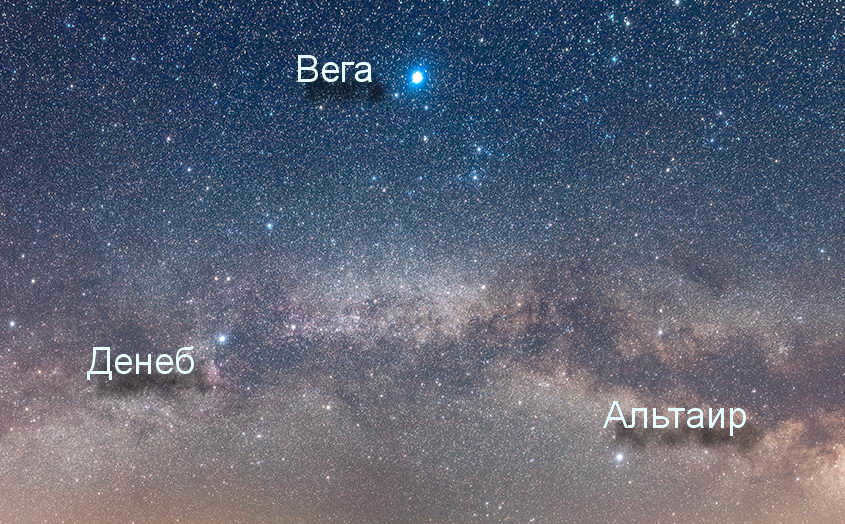
Altair is positioned at the highest point of the Summer Triangle, along with Vega and Deneb. It is also a prominent member of a well-known constellation known as the Eagle Family. This triangle creates a striking contrast against the vast expanse of the Milky Way.
Main Characteristics
Luminosity
The brightness of Altair is 10.7 times higher than that of the Sun, but because of its fast rotation, there is a phenomenon known as gravitational darkening, which causes a decrease in brightness near the star’s equator.
Altair’s coloration is not uniform, and it exhibits irregular bluish-white color transitions. It also emits a relatively weak amount of coronal X-rays, with the majority of activity occurring along the star’s equator.
1. The star has an ellipsoidal shape, rather than being spherical.
2. In 2007, an interferometer captured the first image of Altair’s surface, confirming its flattening and gravitational darkening effects. 3.
3. Despite being relatively close to Earth, scientists are prohibited from approaching it. A telescope with a 300-meter diameter mirror is required for a more detailed study of the star’s surface, but such devices have not yet been built.
4. Altair is part of the asterism known as the “Scale Barrel,” which forms an almost straight line.
5. The star is surrounded by a bright glow called the “Shining Eye,” which is essentially the radiation emitted by the nebula located near the star.
6. In 2007, NASA named its Lunar Module after Altair.
7. Altair possesses three optical satellites that are not physically adjacent but are in direct line of sight. Additionally, in 2005, Altair was discovered to exhibit faintly visible disks.
8. Altair is revered by the Japanese as the patron saint of lovers who are willing to go to any lengths for love. Each year on July 7th, the day of the convergence of Vega and Altair, the renowned traditional festival of Tanabata is celebrated.
9. One of the horses brought by the Magi to the newborn Jesus was named after Altair as a tribute.
10. Altair features prominently in American cinema, where it is depicted as sprawling to the size of a galaxy. It is also the namesake of one of the main characters in the action-adventure computer game Assassin’s Creed. Furthermore, Altair is a recurring theme in numerous works of fiction.
11. Due to its relatively young age, there are currently no predictions regarding the end of Altair’s life cycle.
Altair [1] (α Aql / Alpha Eagle) is the most brilliant star in the constellation Eagle and the twelfth brightest star in the sky, having an apparent luminosity of 0.77. Its name is derived from the Arabic term “an-nasr al-tair” (Arabic النسر الطائر), which means “eagle in flight”.
Altair serves as one of the vertices of the “summer-fall triangle” visible in the Northern Hemisphere throughout the summer and fall seasons. It is characterized as a white, hot star with a spectral class of A7IV-V.
A photograph capturing the surface of Altair was captured in 2007 [2].
The celebrity

Altair, which is situated a mere 16.8 light-years (5.14 parsecs) away from our planet, is easily observable with the naked eye and is considered to be one of the closest stars in proximity to Earth. The precise distance to this celestial body is estimated to be approximately 159 trillion kilometers. When combined with Eagle’s beta and Eagle’s gamma, Altair forms a well-recognized constellation of stars commonly referred to as the Eagle family or Eagle Shaft.
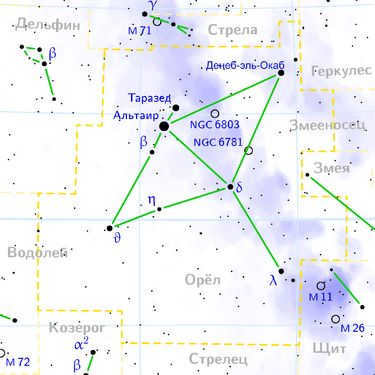
Altair is an A-class main-sequence star with a mass of approximately 1.8 times that of the Sun and a luminosity 11 times greater. Altair has a rapid rotation, completing one full revolution around its axis in just 8.9 hours, with an equatorial velocity of 286 km/s. In comparison, the Sun takes 25.05 days to complete a full revolution at an equatorial speed of 2 km/s. Due to Altair’s fast rotation, its diameter at the equator is 22% larger than at the poles.
In 1999, satellite measurements taken by the Wide Field Infrared Explorer revealed that Altair’s brightness varies slightly, with a range of less than one thousandth of a magnitude. This led to the classification of Altair as a δ Shield type variable in 2005. Its light curve can be approximated by combining several sine waves with periods ranging from 0.8 to 1.5 hours.
Compressing and Regulating Surface Temperatures
An image of the swiftly spinning star Altair, captured by the infrared MIRC camera of the CHARA interferometer at Mount Wilson Observatory, is presented here with colors representing different temperatures. Lighter shades indicate lower temperatures, while darker shades reflect higher temperatures.
In the 1960s, Robert Brown and his team used interferometric measurements to determine Altair’s angular diameter. Their findings revealed that the star has a diameter of 3 angular milliseconds [3]. Additionally, they hypothesized that Altair likely experienced significant compression due to its fast rotation. However, the technology available at that time was not sensitive enough to experimentally verify this hypothesis.
In 1999 and 2000, Gerard van Belle and his co-authors studied Altair using an infrared interferometer at the Palomar Test Center [4]. According to the theory, Altair’s rapid rotation should result in lower surface gravity and effective temperature at the equator, making the equator less bright than the poles. This phenomenon, known as gravitational darkening, was confirmed for Altair in 2001 through measurements taken on an optical interferometer prototype and analyzed by Oishi (2004) and Peterson et al. (2004) [5] [6]. Additionally, Dominicano de Souza (2005) investigated gravitational darkening using measurements obtained with the VINCI instrument at VLTI [7]. Altair is one of the few stars for which direct images of its disks have been captured [8]. The gravitational darkening effect, as well as the flattening effect, can be observed directly [9].
Stars in close proximity
The subsequent stellar systems are located within a radius of 10 light years from Altair:
| Star | Spectral type | Distance, light years |
| Wolf 1055 | M3.5 Ve / M8 Ve | 3.7 |
| 70 Serpent | K0-1 Ve / K5-6 Ve | 7.8 |
| HIP 103039 | ? | 9.1 |
| 61 Swan | K3.5-5 Ve / K4.7-7 Ve | 9.8 |
| V1581 Swan | M5.5 Ve / M6V | 9.8 |
| AC+17 534-10 | M3.5 Ve | 10.0 |
Pop Culture References
Notes
Resources
| The following table displays stellar systems located within a range of 10-20 light-years, with the absolute stellar magnitudes of the brightest member being +8.5 or brighter. | |
| Altair (16.69 ± 0.04 light-years; 1 star) | |
| Procyon (11.44 ± 0.02 light-years; 2 stars) – (yellow-white). | |
| Tau Ceti (11.905 ± 0.007 light-years; 1 star) – Sigma Draconis “Alsafi” (18.77 ± 0.02 light-years; 1 star) – Eta Cassiopeia “Achird” (19.39 ± 0.05 light-years; 2 stars) – 82 Eridani (19.71 ± 0.02 light-years; 1 star, 3 planets: b – c – d) – Delta Pavonis (19.92 ± 0.02 light-years; 1 star) | |
| Epsilon Eridani (10.480 ± 0.003 light-years; 1 star, 2 planets: b- c) – 61 Cygni (11.40 ± 0.02 light-years; 2 stars) – Epsilon Indi (11.81 ± 0.01 light-years; 1 star, 2 brown dwarfs) – Groombridge 1618 (15.87 ± 0.04 light-years; 1 star) – Omicron² (40) Eridani “Keid” (16. 25 ± 0.02 light-years; 3 stars) – 70 Ophiuchi (16.64 ± 0.07 light-years; 2 stars) – Gliese 570 (19.12 ± 0.08 light-years; 3 stars, 1 brown dwarf) – 36 Ophiuchi (19.40 ± 0.05 light-years; 3 stars) – Gliese 783 (19.62 ± 0.04 light-years; 2 stars) | |





